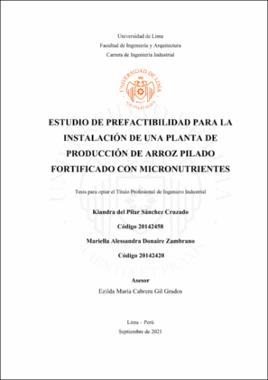Estudio de prefactibilidad para la instalación de una planta de producción de arroz pilado fortificado con micronutrientes

Ver/
Tesis
(application/pdf: 12.16Mb)
(application/pdf: 12.16Mb)
Fecha
2021Asesor(es)
Metadatos
Mostrar el registro completo del ítemResumen
El objetivo general de este proyecto es determinar la viabilidad de mercado, tecnológica,
económica, financiera y social para la instalación de una planta de producción de arroz
pilado fortificado con micronutrientes. En cuanto a la viabilidad de mercado, mediante
encuestas realizadas a la población objetivo, se determinó que el arroz fortificado tiene
una alta aceptación en los niveles socioeconómicos “A” y “B” de Lima Metropolitana,
siendo la demanda del proyecto para el año 2025 aproximadamente de 3,8 millones de
unidades de producto terminado.
En cuanto a la localización de la planta se determinó que la ubicación óptima es
el departamento de Lambayeque específicamente en la provincia de Chiclayo, debido a
la disponibilidad de materia prima y la distancia al mercado objetivo. El tamaño de planta
se determinó por la tecnología utilizada: la operación cuello de botella es el descascarado
del arroz, la cual limita el tamaño de planta a 7 064 891 unidades de producto terminado
al año. El mínimo de unidades de producto terminado vendidas por año para comenzar a
obtener ganancias son 860 521 bolsas (punto de equilibro). Bajo estas consideraciones,
se estableció el programa de producción durante los 5 años de vida útil de proyecto, en
el 2025 esta será de 5 084 881 bolsas y el stock de seguridad de 26 922 bolsas al año.
Con relación a los aspectos económicos y financieros, se determinó que la
inversión total requerida para el proyecto es de S/ 5 889 820. La alternativa más rentable
es solicitar un financiamiento bancario por el 39% de la inversión total, al ser la TIR
financiera 29% y la TIR económica 24%. Considerando el financiamiento el periodo de
recupero de la inversión es de 2 años y 9 meses, y el beneficio de S/ 1,77 por cada S/ 1
invertido.
La finalidad social del proyecto es donar arroz fortificado a las zonas más
vulnerables en términos de nutrición infantil del Perú. En las proyecciones tecnológicas
y financieras se ha considerado que por cada 3 bolsas vendidas se donará 1. Bajo esta
premisa el proyecto se mantiene rentable y además asegura una donación anual hasta de
953 ton en el 2025. The main objective of this project is to determine the market, technological, economic,
financial and social viability for the implementation of a fortified rice plant. The market
viability was determined through a survey conducted to the target population. It was
found that fortified rice has a high acceptance in the socioeconomic levels "A" and "B"
of Lima, indeed the demand by 2025 will be approximately 3,8 million finished good
units.
Regarding the plant’s location, it was determined that the optimal location is the
department of Lambayeque, specifically the city of Chiclayo due to its proximity to the
raw material and the distance to the target market. The plant capacity is determined by
the technology: the rice peeling process is the bottleneck operation in the production
chain, limiting the capacity to 7 064 892 finished good units per year. At least 860 521
fortified rice bags have to be sold per year to start earning profits (break-even point).
Under these considerations, the production program for the 5 years project was
determined and in 2025 the production will rise to 5 084 881 fortified rice bags and the
safety stock will be 26 922 bags per year
As for the economic and financial aspects, the total investment required for the
project is 5 889 820 PEN. The most profitable option isrequesting a 5-year loan to finance
39% of the total investment, since the financial IRR is 29% and the economic IRR is
24%. By opting for financing, the period of recovery of the investment will be 2 year and
9 months, and for every S/ 1 invested S/ 1,77 will be earn.
The social purpose of this project is donating fortified rice to the most vulnerable
population in Peru especially those with nutritional deficiencies. The technological and
financial projections of this project already consider that for every 3 sold bags 1 will be
donated. Under this consideration the project remains profitable and ensures an annual
donation up to 953 tons of fortified rise in 2025.
Cómo citar
Sánchez Cruzado, K. P. y Donaire Zambrano, M. A. (2021). Estudio de prefactibilidad para la instalación de una planta de producción de arroz pilado fortificado con micronutrientes [Tesis para optar el Título Profesional de Ingeniero Industrial, Universidad de Lima]. Repositorio institucional de la Universidad de Lima. https://hdl.handle.net/20.500.12724/14754Editor
Universidad de LimaTemas
Coleccion(es)
- Tesis [1167]
El ítem tiene asociados los siguientes ficheros de licencia:

